A triple candlestick pattern is a price chart formation consisting of three candlesticks that signal either a trend reversal or a trend continuation. Triple candlestick patterns are specific formations which are used by investors and traders to predict how the price of a security is going to behave. The structure of triple candlestick patterns includes three candlesticks with bodies and upper and lower shadows of varying lengths.
The signals given by a triple candlestick pattern differ depending on the type of the triple candlestick pattern. There are mainly fifteen types of triple candlestick patterns. Each pattern has its distinct structure and each conveys a different meaning to investors and traders. The fifteen types of triple candlestick patterns include morning star doji, morning star, evening star doji, evening star, three white soldiers, three black crows, bullish abandoned baby, bearish abandoned baby, rising three, falling three, three outside up, three outside down, three inside up, three inside down, and tristar.
Triple candlestick patterns are used in technical analysis to predict upcoming price movements. Investors and traders study and analyse the triple candlesticks, identify their type and draw conclusions accordingly. The signals produced by the triple candlesticks help investors and traders plan their trading strategies including their entry and exit positions.
What does a Triple Candlestick mean?
Triple candlestick patterns are specific price chart formations that are made up of three candlesticks. The term triple candlestick pattern refers to a broad category of fifteen candlestick patterns, each formed of three candlesticks. A candlestick is a tool that uses past price data to predict upcoming price movements. A candlestick reflects four daily price points namely the open, close, high and low prices. A triple candlestick pattern is a group of specific patterns, made up of three such candlesticks.
Triple candlestick patterns are types of candlestick patterns that are important predictors of how the active market trend is going to behave next. Triple candlestick patterns predict bullish and bearish trend reversals as well as trend continuation. The signals that triple candlestick patterns produce depend on the type of triple candlestick pattern that is formed.
The morning star, morning star doji, the bullish abandoned baby, the three white soldiers, the three inside up, and the three outside up signal bullish reversals while the evening star, the evening star doji, the bearish abandoned baby, the three black crows, the three inside down, and the three outside down signal bearish reversals. Some triple candlesticks such as the rising three and falling three also signal trend continuation.
How is a Triple Candlestick Pattern structured?
The structure of a triple candlestick pattern comprises three candlesticks, each with bodies and upper and lower shadows of varying lengths. The structure of a triple candlestick pattern depends on the type of triple candlestick. Investors and traders must look for specific candlestick patterns that are formed of three candlesticks to identify a triple candlestick pattern. Each candlestick in a triple candlestick pattern has specific structural conditions that it must fulfil, to be considered a contributing part of the triple candlestick pattern. The basic structure of a candlestick is described using the image below.
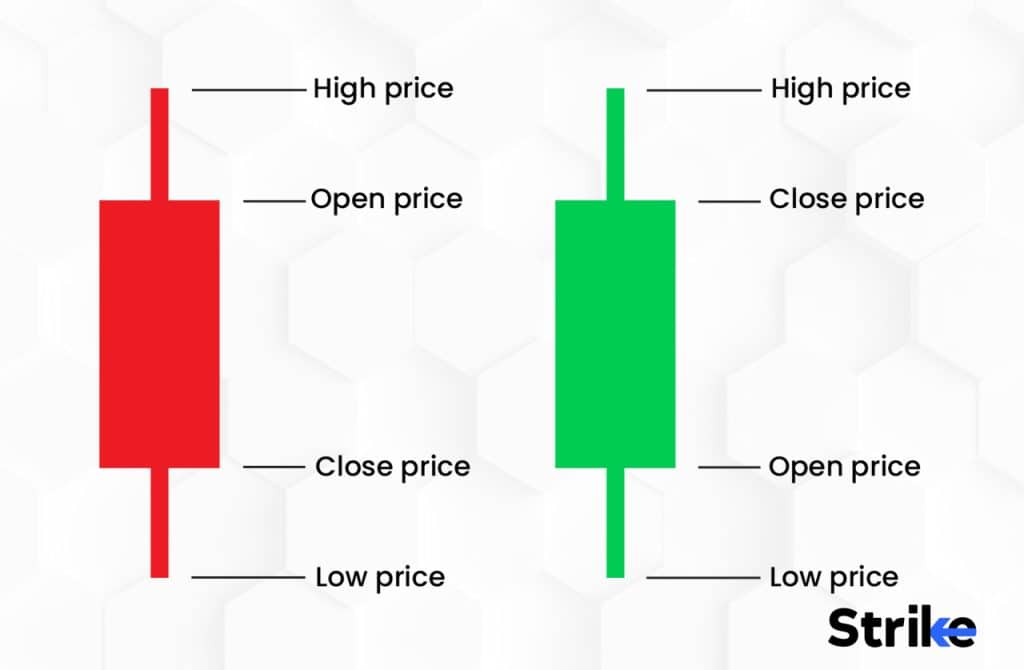
The image above shows that a candlestick consists of a rectangular part known as the body and two upper and lower lines known as shadows or wicks. The upper and lower wicks or shadows mark the daily high and low prices respectively. Bearish candlesticks that represent a price drop are filled with a dark colour such as red or black and bullish candlesticks representing a price increase are either green or white.
There are totally fifteen different triple candlestick formations and each has its distinct structure. Investors and traders must be aware of the structures of the different triple candlestick formations as each signifies a different meaning and interpretation. The image below depicts two triple candlestick formations, the morning star and evening star pattern.
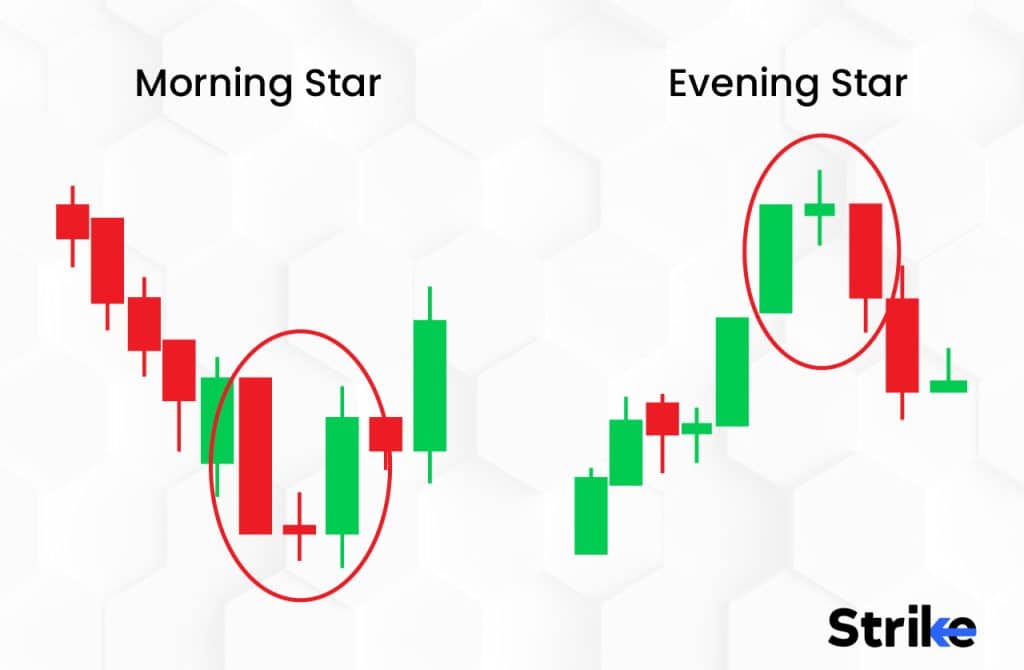
The image shows that the structure of both patterns comprises three candlesticks each with bodies and wicks of varying lengths. The first image of the morning star pattern consists of one bearish candlestick, a candlestick with a small body and then finally a bullish candlestick. The morning star is considered a sign of a bullish reversal. The second image is that of an evening star. The evening star comprises a bullish candlestick, a bullish candlestick with a small body and then a bearish candlestick, signalling a bearish trend reversal.
The image below shows another triple candlestick pattern that is known as three inside down.
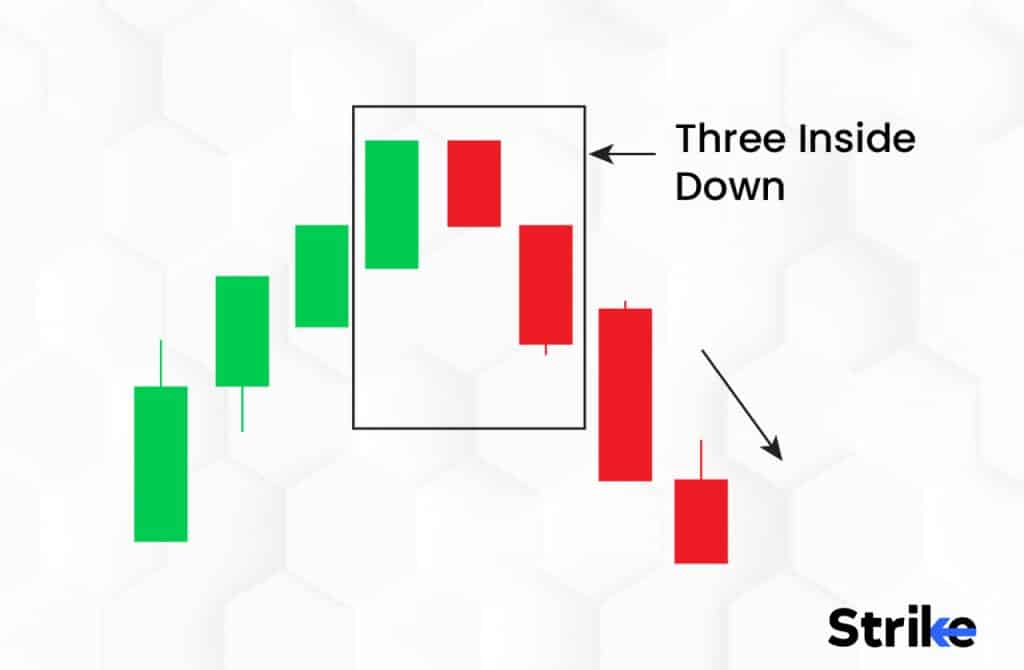
The image above shows that the structure of the three inside down patterns consists of three candlesticks including a first bullish candlestick with a long body, a second bearish candlestick with a body that is more than half the length of the first bullish candlestick and a third bearish candlestick with a close that is lower than that of the second candlestick. The image shows that the structure of the three inside down candlestick signals a bearish trend reversal. Each of the fifteen types of triple candlestick formations, similarly, has a specific structure and conveys a specific signal to investors and traders.
What are the Different Types of Triple Candlestick Patterns?
There are totally fifteen main types of triple candlestick patterns. Each of these patterns conveys a different signal to the investors and traders. They either signal bullish and bearish trend reversals or signal trend continuation. The fifteen different types of triple candlestick patterns are listed below.
1. Morning Star Doji
A morning star doji is a triple candlestick pattern comprising a long black or red (bearish) candlestick, a doji candlestick in the centre and finally a tall white or green candlestick. A morning doji star pattern is a bullish trend reversal indicator. The image above portrays a morning star doji pattern. The second candlestick in the image is the doji candlestick. A doji candlestick is a candlestick pattern in which the body is just a horizontal line as the open and close either coincide or fall very close to each other. The image above shows that the upper and lower shadows of a doji are of varying lengths and the pattern resembles a plus or cross sign. In a morning star doji, the central doji represents the indecision and uncertainty that is present in the market. The indecision foreshadows the trend reversal that is about to happen.
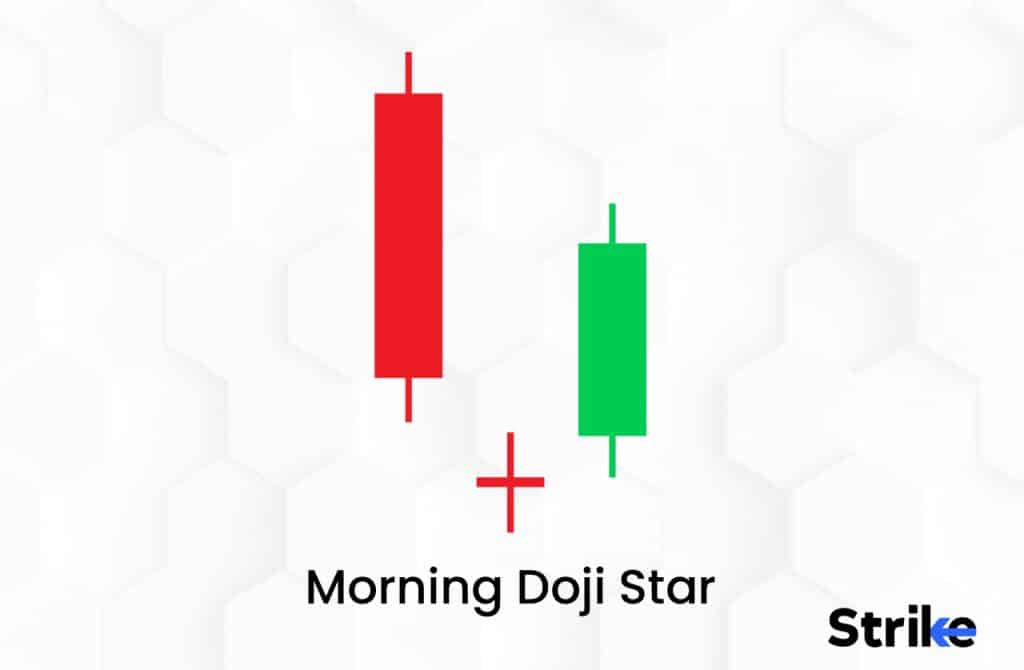
A morning star doji is formed when the bears start to lose the dominating position over the bulls after a prolonged bearish trend. The open and close price of the security gets balanced as a result of the bears losing their position, leading to the formation of the doji candlestick. The doji is then followed by a bullish candlestick that is formed when the bulls start to dominate over the bears. The third bullish candlestick signifies that a bullish trend reversal is imminent.
Morning star doji are identified by the distinct formation of their pattern with a first tall bearish candlestick that is followed by a second doji candlestick and a third tall bullish candlestick pattern. The morning star doji is a bullish trend reversal pattern. It is different from the morning star in the formation of the central candlestick. In a morning star doji candlestick pattern, the central candlestick is a doji candlestick. In a morning star candlestick pattern, on the other hand, the central candlestick is a small bearish or bullish candlestick with a short body and long upper and lower shadows. The indecision that a morning star doji pattern reflects is more pronounced than that a morning star pattern represents.
2. Morning Star
A morning star candlestick pattern is a triple candlestick pattern that consists of a tall bearish candlestick, a central bullish or bearish candlestick with a small body as well as a long bullish candlestick. Morning star candlesticks occur at the end of a downtrend and signal the trend reversal to an uptrend. The image above depicts a morning star candlestick pattern. The image above shows morning star candlestick patterns can be identified by their formation of three candlesticks including a long bearish candlestick, a bearish or bullish candlestick with a small body and a long bullish candlestick at the last.
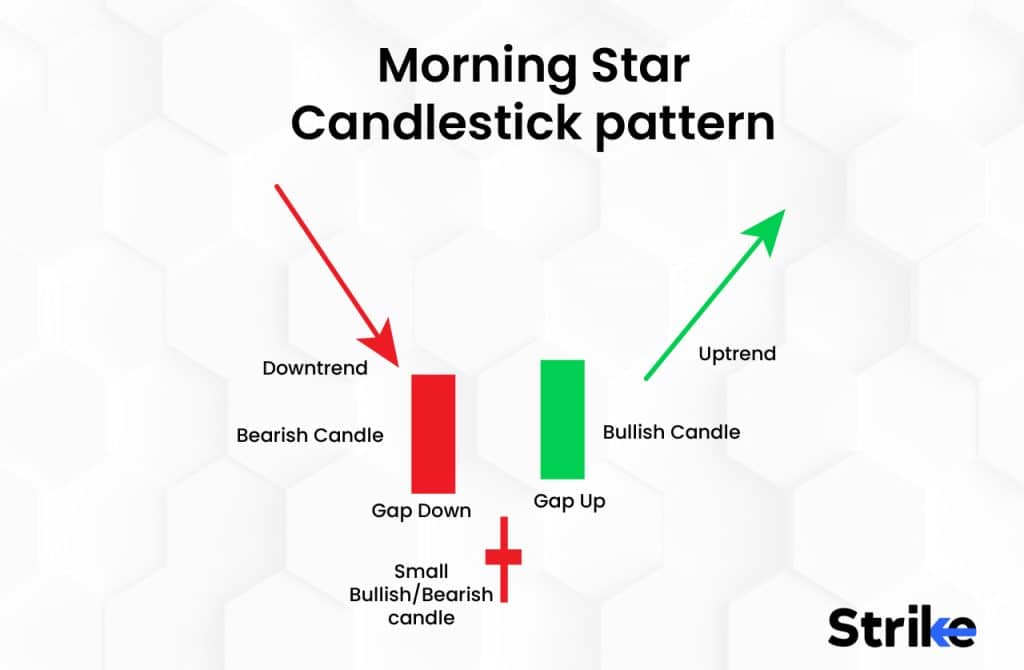
A morning star candlestick is formed when there is indecision prevalent in the market following a downtrend. The indecision leads to the formation of a middle candlestick with a small body signifying that the bulls are catching up with the bears. The final candlestick is formed as a result of the bulls’ takeover from the bears.
They are different from morning star doji candlestick patterns with respect to the middle candlestick. Morning star candlestick patterns have a middle candlestick with a small body, whereas morning star doji candlesticks have a doji in the middle. The morning star candlesticks are the opposite of evening star candlestick patterns which signal bearish trend reversals.
3. Evening Star Doji
The evening star doji is a triple candlestick pattern that investors and traders use to predict upcoming bearish trend reversals. An evening star doji pattern is a distinct formation consisting of a long bullish candlestick, a doji in the middle and a bearish candlestick at the end. The image above shows an evening star doji pattern and its distinct structure with a doji at the centre and a bullish and bearish candlestick on either side. Evening star doji patterns are identified using their distinct structures. The evening star doji candlestick pattern forms over a span of three days with the first candlestick forming on the first day, the middle one on the second day and the last on the third day.
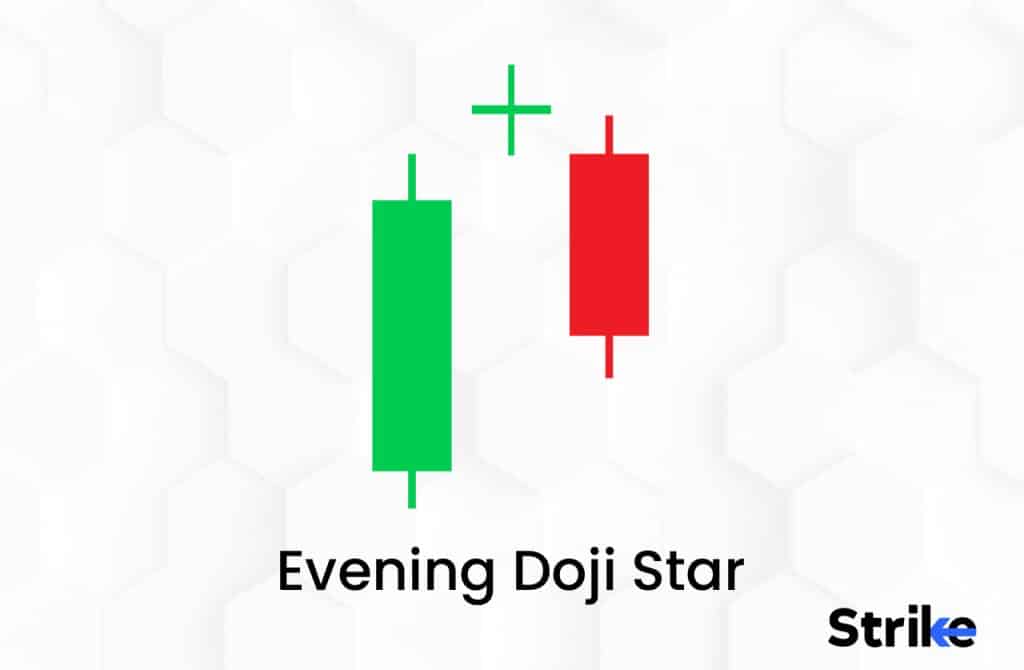
An evening star doji is formed at the end of a bullish trend, just before the trend reverses to a bearish one. The transition from a bullish trend to a bearish one is marked by the middle doji candlestick pattern. The middle doji represents the indecision that is prevailing in the market sentiment right before the trend gets reversed. The evening star doji pattern is the exact opposite of the morning star doji pattern. The evening star doji pattern is similar to the evening star pattern. The two differ in only one aspect which is in how pronounced the market indecision is. In evening star doji patterns, the market indecision is high compared to the evening star.
4. Evening Star
The evening star candlestick pattern is a triple candlestick pattern that consists of a long bullish candlestick, a bullish or bearish candlestick with a short body and a final bearish candlestick. Evening star candlestick patterns are considered bearish trend reversal indicators. The image above represents an evening star candlestick pattern.
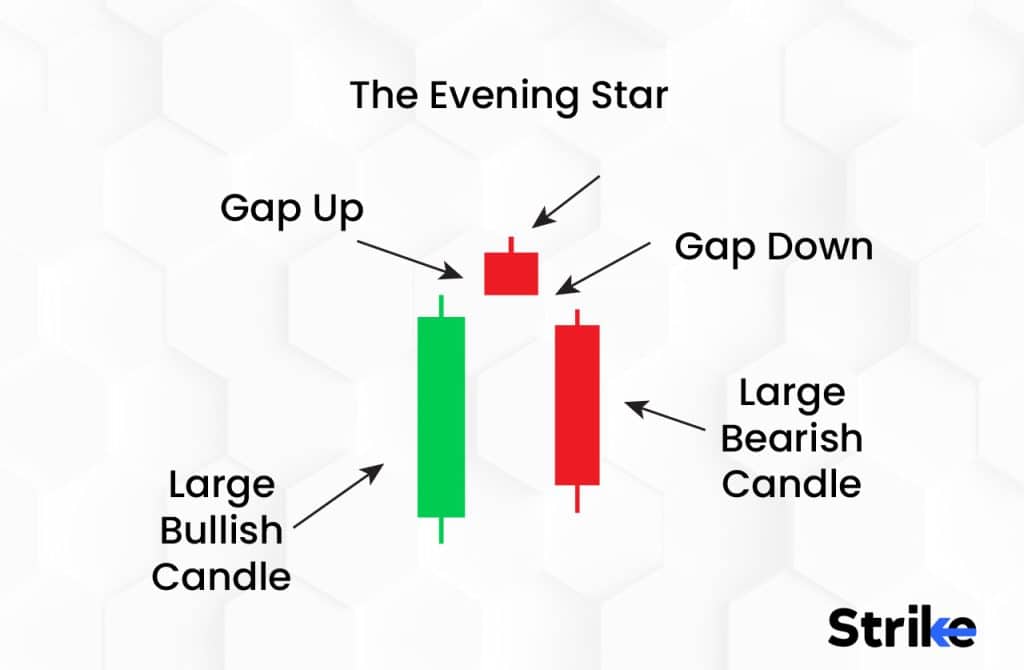
Evening star candlestick patterns are formed at the end of uptrends when the price of the security was on a steady advance. The bulls are in a dominating position at the start of the formation of the evening star. The short-bodied-candlestick, in the image above, represents the change in the market sentiment as a move is being made from a bullish trend to a bearish one. The middle candlestick in the evening star pattern stands for the uncertainty that is formed as the bulls start to lose the dominating hold that they had over the price to the bears. The final third candlestick in the formation is a long bearish candlestick that is formed due to the bears taking over the bulls and dragging the prices down.
The evening star candlesticks are identified by their specific triple candlestick structure with a tall bullish candlestick, a central candlestick with a small body and a tall final bearish candlestick. Evening star candlesticks are the exact opposite of the morning star. Evening star candlesticks also show similarities with the evening star doji patterns with the only difference being that the market indecision in an evening star doji candlestick pattern is stronger than that in an evening star candlestick pattern.
5. Three White Soldiers
Three white soldiers is a triple candlestick pattern that signals bullish trend reversals. Three white soldiers consist of three long bullish candlesticks, with each candlestick opening at a position within the previous candlestick’s body and closing at a point that exceeds the previous candlestick’s high price. The image above showcases three white soldiers candlestick pattern. The candlesticks do not mandatorily have to be white, as inferred by their name. The candlesticks can be green or white since both colours represent bullish candlesticks. Investors and traders consider the three white soldiers an accurate and reliable indicator and are very commonly used in combination with other technical indicators such as the Relative Strength Index (RSI). The image indicates that the candlesticks in the three white soldiers’ patterns do not have long wicks or shadows. Investors consider it a sign of retracement if the length of the three white soldier’s candlesticks is long.
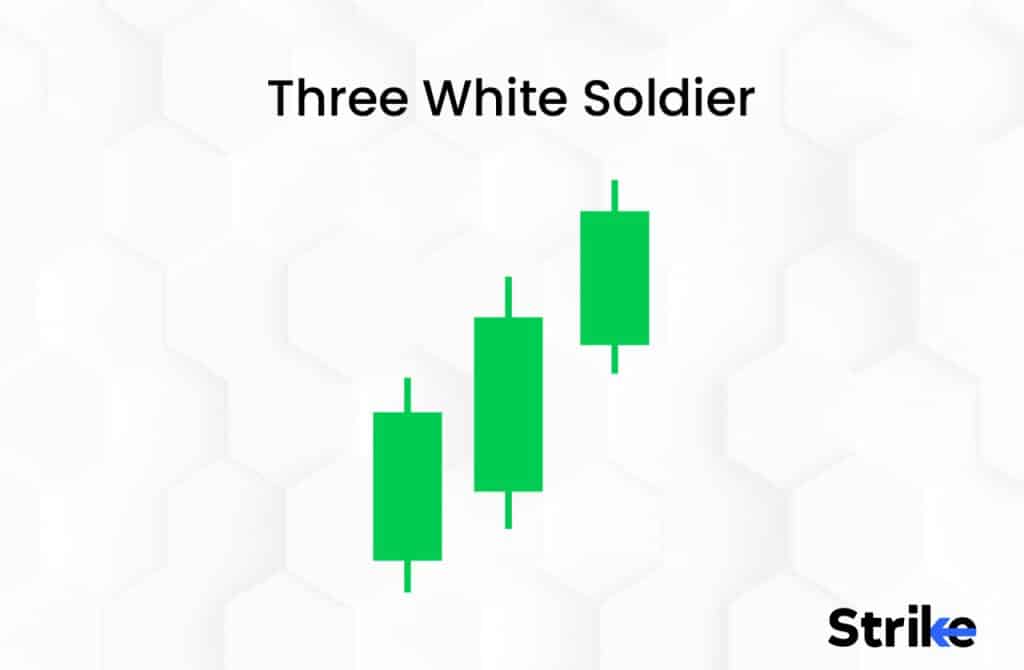
The three white soldiers’ candlestick pattern is formed when the bulls start gaining an advantage over the bears. The lack of shadows and wicks shows that the bulls have been successful in dragging the prices higher and maintaining them. The pattern can be identified by its structure which consists of three long green or white bullish candlesticks. The key aspect of identifying a three-white soldier pattern is that the open price of each candlestick must fall within the body of the previous candlestick and the close price of each candlestick must be above the high price of the previous candlestick.
Three white soldiers belong to the category of bullish trend reversal triple candlestick patterns. The exact opposite of the three white soldiers pattern is the three black crows’ candlestick pattern.
6. Three Black Crows
Three black crows is a triple candlestick pattern that signals bearish trend reversals. Three black crows consist of three long bearish candlesticks, with each candlestick opening at a position within the previous candlestick’s body and closing at a point that is lower than the previous candlestick’s low price. The image above showcases a three-black crows candlestick pattern. The candlesticks do not necessarily have to be black, as the name suggests. The candlesticks can be red or black since both colours represent bearish candlesticks. Investors and traders consider the three black crows an accurate and reliable indicator and are often used along with other indicators. The image above indicates that the candlesticks in the three black crows pattern do not have long wicks or shadows. Investors consider it a sign of a change in the direction of the price movent if the lengths of the three black crows’ candlesticks are long.
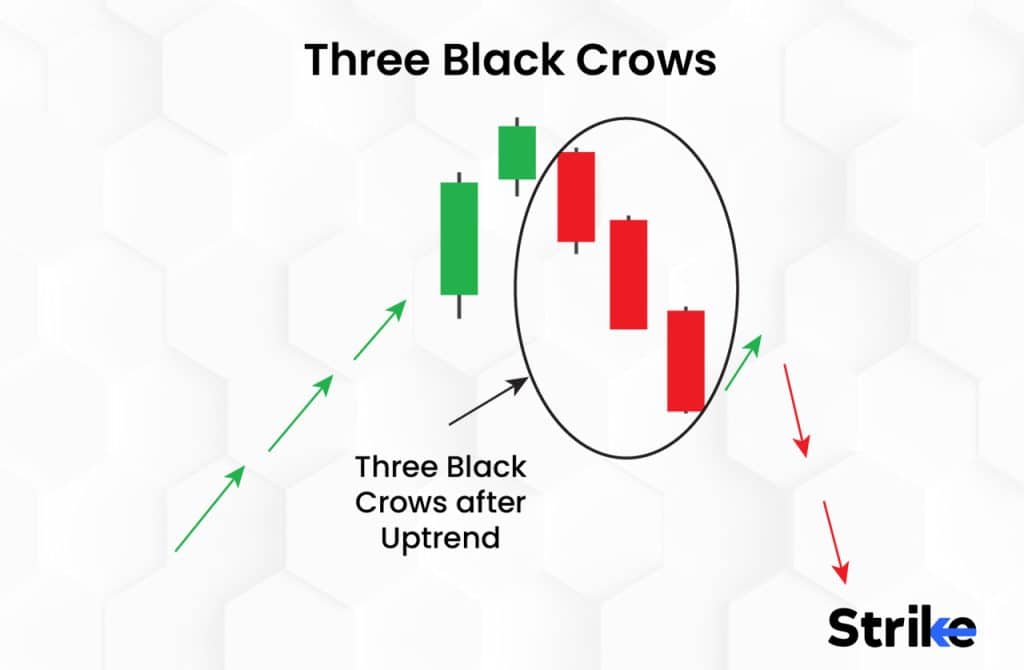
The three black crows candlestick pattern is formed as a result of the bears starting to gain an advantageous position over the bulls. The lack of shadows or the presence of small shadows shows that the bears have been successful in dragging the prices lower and maintaining them. The three black crows’ pattern can be identified by its structure which consists of three long red or black bullish candlesticks. The main feature to keep in mind while identifying a three black crows pattern is that the open price of each candlestick must fall within the body of the previous candlestick and the close price of each candlestick must be below the low price of the previous candlestick.
Three black crows are bearish trend reversal candlestick patterns. The exact opposite of the three black crows pattern is the bullish trend reversal three white soldiers candlestick pattern.
7. Bullish Abandoned Baby
The bullish abandoned baby is a triple candlestick pattern that signals the end of a downtrend. The bullish abandoned baby pattern is identified by its specific formation consisting of three candlesticks including a tall bearish candlestick, a doji in the middle and finally a tall bullish candlestick. The bullish abandoned baby usually has gaps between the first, second and third candlesticks. A gap is a discontinuous area that is formed in the price chart in between the trading hours owing to abrupt price fluctuations. The image above represents the bullish abandoned baby pattern with gaps between the candlestick.
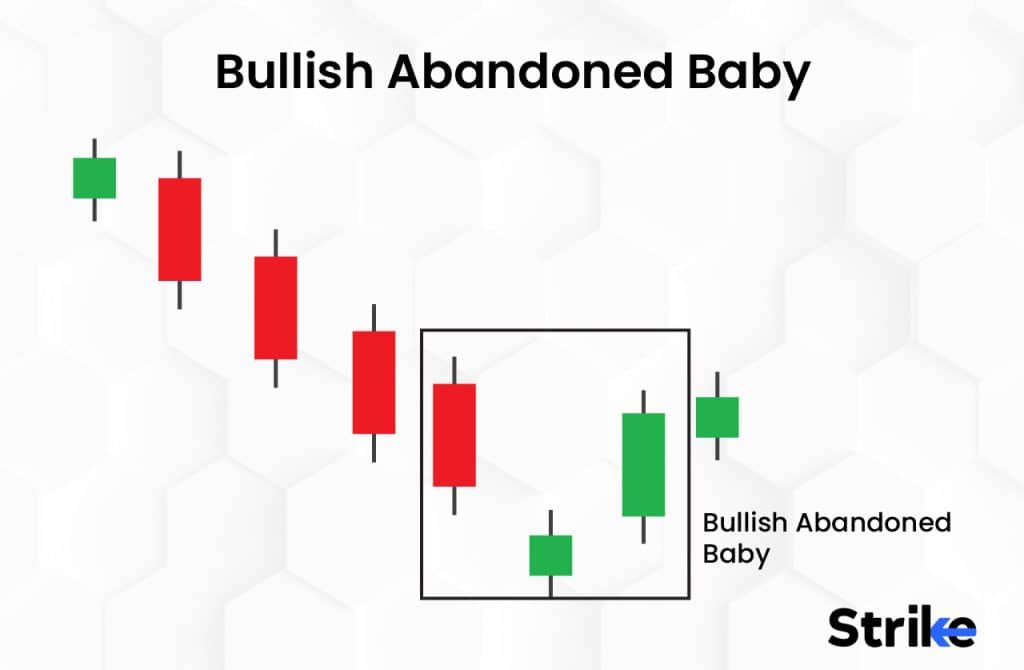
The bullish abandoned baby is formed at the end of a downtrend. The bullish abandoned baby pattern begins in an ongoing downtrend which is why the first candlestick in the pattern is a strong bearish candlestick. The second candlestick of the pattern is a doji gapping below the close of the previous candlestick. The doji is formed owing to the balance that is being established between the demand and supply and that the bulls are catching up to the bears. The third candlestick is a bullish candlestick that gaps higher than the doji candlestick. The bullish candlestick is formed when the buyers or bulls regain an advantageous position over the sellers or bears.
There are variations to the bullish abandoned candlestick pattern with the formation of more than one doji in the middle. It is common to find three or four dojis in bullish abandoned baby patterns before the appearance of the final bullish candlestick. The bearish abandoned baby is the exact opposite of the bullish abandoned baby. The two are rare patterns with a high degree of accuracy compared to other patterns such as the morning and evening star patterns.
8. Bearish Abandoned Baby
The bearish abandoned baby is a triple candlestick pattern that signals the end of an uptrend. The bearish abandoned baby pattern is identified by its characteristic formation consisting of three candlesticks including a strong bullish candlestick, a doji in the middle and lastly a strong bearish candlestick. The image above represents the bullish abandoned baby pattern with its three distinct candlesticks that contribute to the pattern. Like the bullish abandoned baby, the bearish abandoned baby also usually has gaps between the first, second and third candlesticks. The image above shows the gaps between three candlesticks.
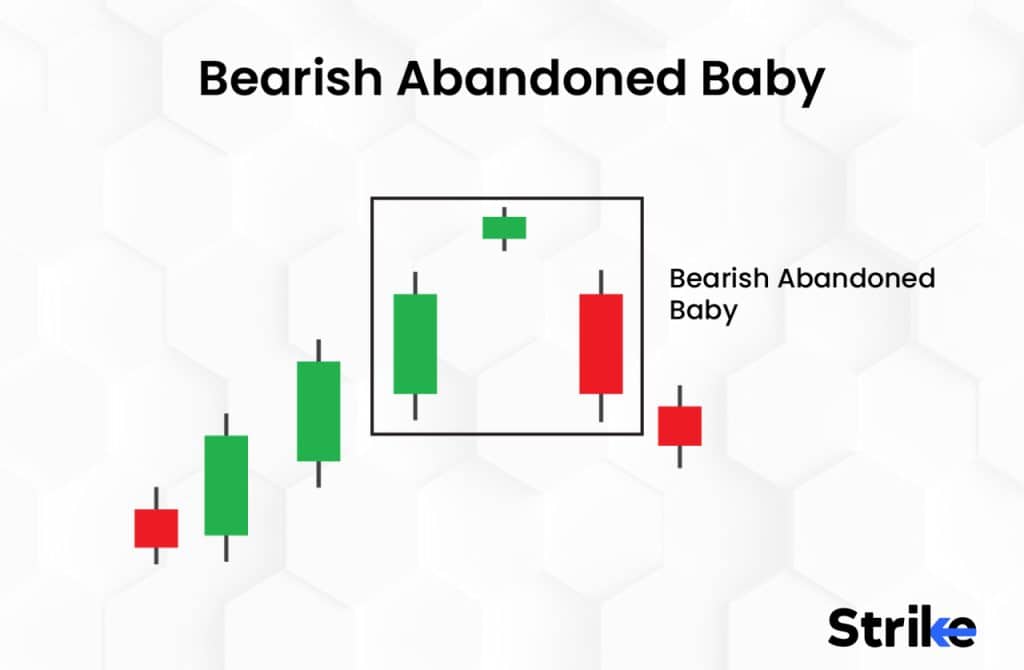
The bearish abandoned baby is formed at the end of an uptrend. The bearish abandoned baby pattern starts in an uptrend owing to which the first candlestick in the pattern is a strong bullish candlestick. The second candlestick of the pattern is a doji gapping above the close of the previous candlestick. The doji is formed owing to the balance that is being established between the demand and supply and shows that selling is balancing out the buying. The third candlestick is a bearish candlestick that gaps lower than the doji candlestick. The bullish candlestick is formed when the bears establish a dominating position over the bulls, thereby bringing about a bearish trend reversal.
The bearish abandoned baby is considered an extremely reliable indicator of a bearish trend reversal. The reliability of the two abandoned baby patterns is higher than that of other triple candlestick patterns. The abandoned baby patterns are, however, rare patterns. The bullish abandoned baby is the opposite variation of the bullish abandoned baby.
9. Rising Three
The rising three candlestick pattern is a bullish five-candlestick pattern that signifies a continuation of the bullish trend. The rising three candlestick pattern occurs in the middle of an ongoing uptrend. The image above represents a rising three candlestick where there is a strong bullish candlestick, three bearish candlesticks with small bodies that trade below the high and above the low of the previous candlestick, and a final strong bullish candlestick. Investors and traders look for its special five-candlestick formation to identify the rising three candlestick pattern. The fifth and final candlestick in a rising three pattern breaks the high of the first candlestick in the pattern and closes above it. The final candlestick in a rising three pattern is important as it stands for confirmation that the bullish trend is to continue.
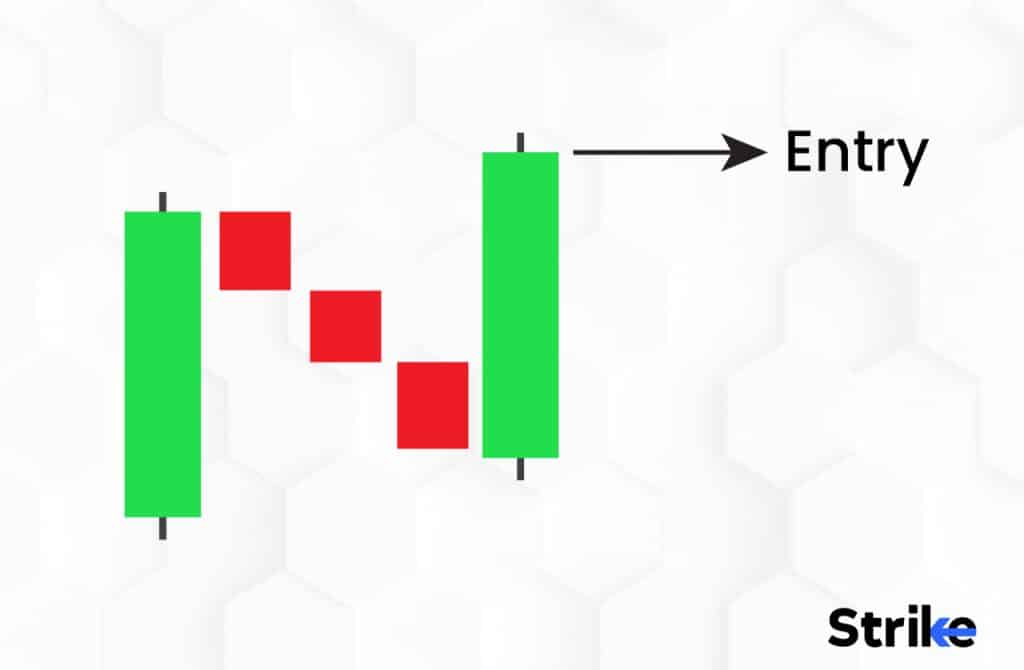
A rising three candlestick pattern forms when there is a strong ongoing uptrend that is followed by a pause before a continuation of the bullish trend. The three bearish candles with the small bodies stand for the pause in the uptrend where the bulls are waiting to see if the trend is strong enough to be continued. The final candlestick confirms that the bulls are still in a winning position and that the uptrend is to continue.
The rising three patterns is a trend continuation indicator. It is the exact opposite of the falling three, which is considered a bearish trend continual indicator. Unlike the other indicators such as the morning or evening star or the three white soldiers or three black crows, the rising three pattern does not signal any reversal of trends. The rising three patterns, instead, checks for the strength of the trend and confirms its continuation.
10. Falling Three
The falling three candlestick pattern is a bearish five-candlestick pattern that is a trend continuation indicator, The falling three candlestick pattern occurs during an ongoing bearish trend. The image above represents a falling three candlestick where there is a first strong bearish candlestick, three bullish candlesticks with small bodies that trade below the high and above the low of the previous candlestick in the centre, and a final strong bearish candlestick. Investors and traders identify the falling three pattern using its distinct five-candlestick structure with two strong bearish candlesticks on either side and three small-bodied bullish candlesticks in the middle. The final fifth candlestick in a falling three pattern breaks the low of the first candlestick in the pattern and closes below it, indicating the continuation of the bearish trend.
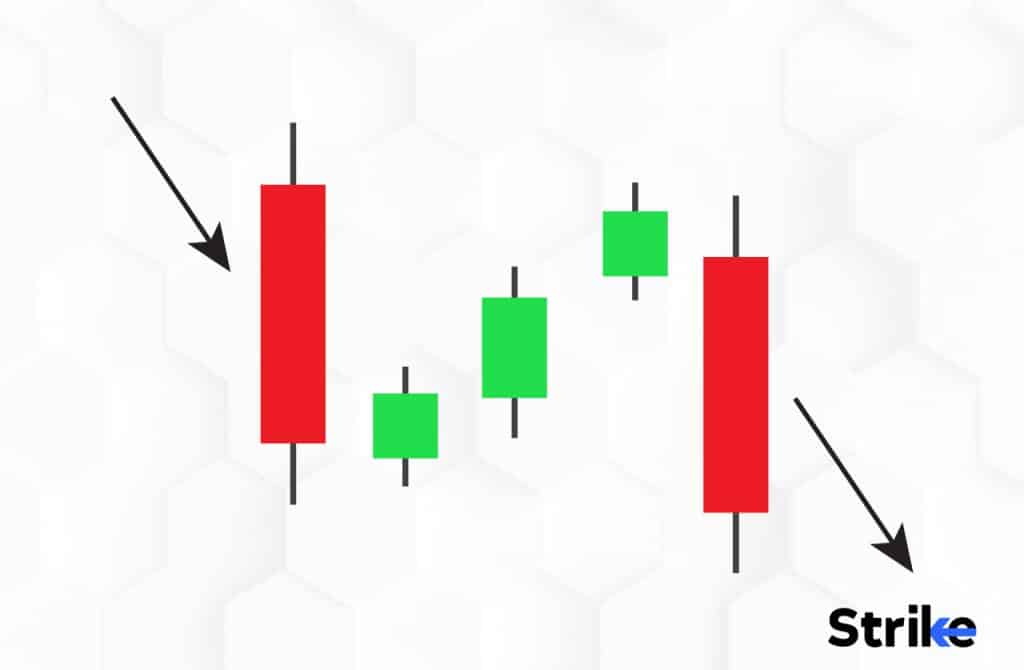
A falling three candlestick pattern forms when there is a strong ongoing downtrend that is followed by a pause before the continuation of the downtrend. The three bullish candlesticks in the middle represent the pause in the downtrend, where the bears are waiting to see if the trend is strong enough to be continued. The final candlestick confirms that the bears are still in a dominating position and that the bearish trend is to continue.
The falling three pattern is a trend continuation indicator. It is the exact opposite of the rising three candlestick pattern, which is considered a bullish trend continual indicator. Unlike the other indicators such as the morning or evening star or the three white soldiers or three black crows, the falling three pattern signals an interruption in the active trend before confirming its continuation.
11. Three Outside Up
The three outside up pattern is a triple candlestick pattern that signals a bullish trend reversal. The three outside up pattern consists of a first bearish candlestick, a second bullish candlestick with a body that is longer than the entire first candlestick and a third bullish candlestick that closes at a price higher than that of the second candlestick. The image above represents the particular pattern of formation of the three outside up. Three outside up candlestick is identified using its specific formation in which two bullish candlestick immediately follow the initial bearish candlestick.
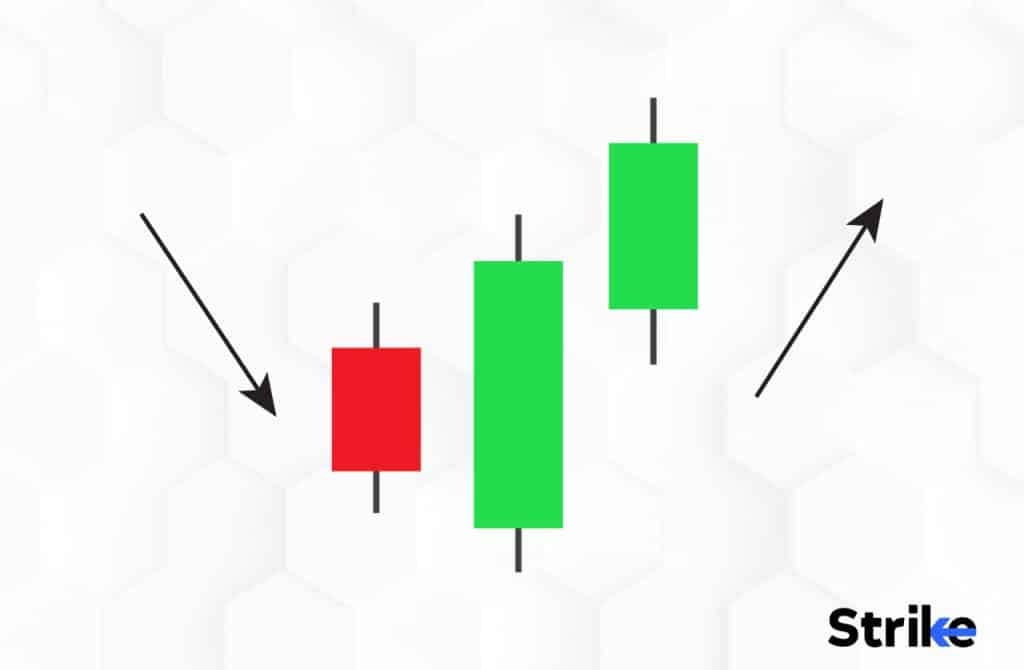
A three outside up candlestick is formed at the end of a downtrend, making the initial candlestick of the formation a bearish candlestick. The second candlestick opens lower than the second but this candlestick marks the trend reversal as it closes at a price that is higher than the previous candlestick’s high. The third candlestick of the pattern is formed as the bulls take over the bears, confirming that a trend reversal is about to take place.
Three outside up candlesticks are the exact opposite of the three outside down candlesticks which are bearish trend reversal indicators. Both the three outside up and down candlesticks patterns are patterns based on market psychology which tracks changes in the market sentiment.
12. Three Outside Down
The three outside down pattern is a triple candlestick pattern that signals a bearish trend reversal. The three outside down pattern consists of a first bullish candlestick, a second bearish candlestick with a body that is longer than the length of the entire first candlestick and a third bullish candlestick that closes at a price lower than that of the second candlestick. The image above represents the particular pattern of formation of the three outside down. Three outside down candlesticks are identified using its three consecutive candlestick formation with two bearish candlesticks that immediately follow an initial bullish candlestick.
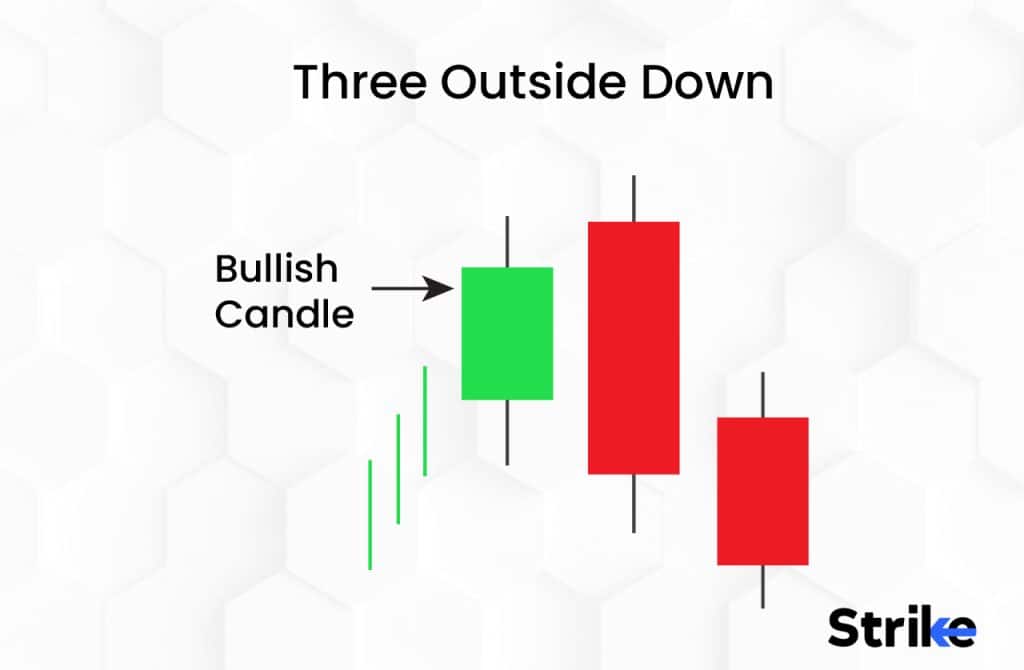
A three outside down candlestick is formed at the end of a bullish trend, making the initial candlestick of the formation a bullish candlestick. The second candlestick opens higher than the second, keeping with the bullish trend but reverses later in the day and closes at a price that is lower than the previous candlestick’s low. The third candlestick of the pattern is formed as the bears take over the bulls, completely, confirming that a bearish trend reversal is about to take place.
Three outside down candlesticks are the exact opposite of the three outside up candlesticks which are bullish trend reversal indicators. Like the three outside up, the three outside down pattern also works on market psychology by assessing changes to the market sentiment.
13. Three Inside Up
The three inside up is a triple candlestick pattern that signals bullish trend reversals. The three inside up candlestick comprises a long bearish candlestick, a second small-bodied-bullish candlestick that has its open and close price lying within the body of the first candlestick and a long bullish candlestick closing above the close of the candlestick in the middle. The image above represents the specific structure of the three inside up patterns. Investors and traders look for its structure with the specific characteristics in candlestick patterns to identify the three inside up candlestick patterns.
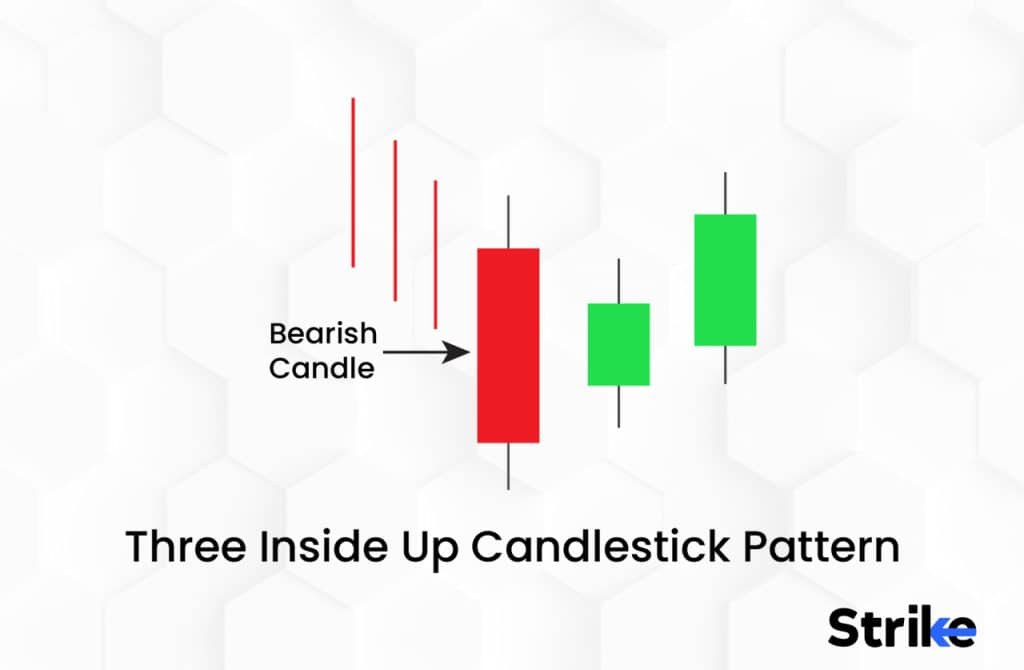
A three inside up candlestick pattern is formed towards the end of a downtrend, which is why the first candlestick in the pattern is bearish. In the beginning, the sellers or bears are in a dominating position. The second candlestick however, opens within the body of the first and closes at a price that is higher than that of the previous candlestick’s close. The second candlestick marks the change in the trend. The third candlestick confirms the bullish trend reversal as it closes higher than the prior candlestick’s close.
Three inside down candlesticks which are bearish trend reversal indicators are the opposite of the three inside up candlesticks, The reliability of both patterns is however considered to be less when compared to other triple candlestick patterns. The trend reversals indicated by the three inside up and down often do not lead to a significant trend reversal. Investors consider the signals of three inside up and down patterns as short-term signals with limited reliability.
14. Three Inside Down
The three inside down is a triple candlestick pattern that signals bearish trend reversals. The three inside down candlestick comprises a long bullish candlestick, a second small-bodied-bearish candlestick that has its open and close price lying within the body of the first candlestick and a long bearish candlestick closing below the close of the candlestick in the middle. The image above represents the structure of the three inside down candlestick patterns. Investors and traders identify three inside down candlesticks through the structure of the candlesticks that contribute to their formation.

A three inside down candlestick pattern is formed towards the end of an uptrend, thereby making the first candlestick in the pattern a bullish candlestick. The buyers or bulls are in a dominating position at the beginning of the three inside down formation. The second candlestick however, opens within the body of the first and closes at a price that is lower than that of the previous candlestick’s close. The second candlestick is the one that marks the trend reversal. The third candlestick confirms the bearish trend reversal as it closes lower than the prior candlestick’s close.
Three inside up candlesticks which are bullish trend reversal indicators are the opposite of the three inside down candlesticks, Like the three inside up candlestick, the three inside down candlestick has limited reliability when compared to other triple candlestick patterns. The three inside down signals of trend reversal are often false and do not lead to a significant trend reversal. Investors consider the three inside down pattern as a short-term signal that lacks long-term reliability.
15. Tristar
A tristar pattern is a triple candlestick pattern that signals bearish or bullish trend reversals. A tristar pattern is formed of three consecutive doji patterns. A doji is a candlestick pattern in which the open and close prices either coincide or fall very close to one another. The image above shows a tristar pattern formed of three consecutively appearing doji candlesticks. Tristar patterns are easy to identify as investors and traders only need to identify three dojis that appear consecutively at the end of a prolonged market trend. The image above indicates that each doji candlesticks resemble a plus or cross sign.
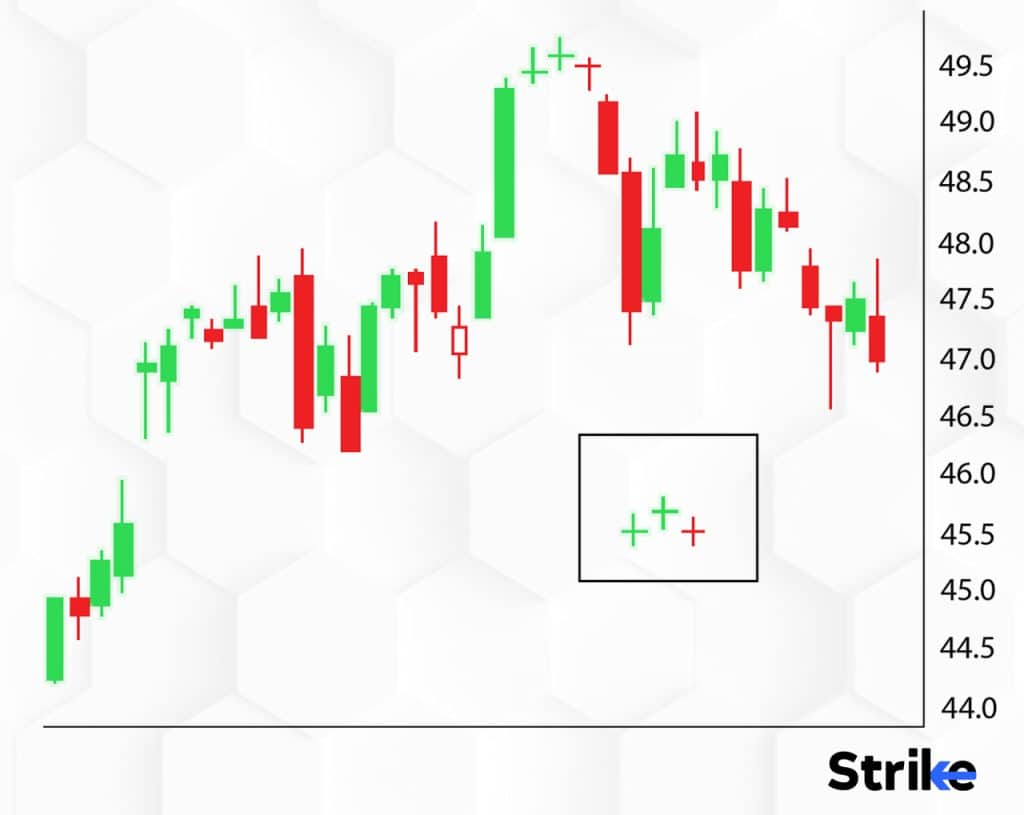
A tristar pattern is formed towards the end of a prolonged market trend which can be either bullish or bearish. The doji patterns form as a result of the indecision prevalent in the market and signal a trend reversal. Bearish tristar patterns signal bearish trend reversals after a bullish trend and bullish tristar patterns signal a bullish trend reversal after a prolonged bearish period.
Unlike other candlestick patterns, the tristar doji is an extremely rare formation. It, however, signals a sharp trend reversal when it occurs as the occurrence of three doji candlesticks in a row signifies a very heightened level of uncertainty in the market with a high probability of resulting in a trend reversal.
Investors and traders must be aware of the features and characteristics of each triple candlestick pattern in order to be able to identify them on a price chart. The correct identification of the triple candlestick patterns goes a long way in helping decide on the right investment strategy.
What is the most powerful Triple Candlestick Pattern?
There is no single most powerful triple candlestick pattern. Each of the fifteen triple candlestick patterns has its pros and cons. The triple candlestick patterns provide the most accurate results when used along with other technical indicators like the RSI. The three white soldiers, three black crows, tristar pattern, and bearish and bullish abandoned baby are some of the powerful and reliable triple candlestick patterns.
How to use Triple Candlestick Patterns in Technical Analysis?
Investors and traders use triple candlestick patterns in their technical analysis through price chart analysis. There are three main steps to using triple candlestick patterns in technical analysis, The first step is a study and analysis of the fifteen different types of triple candlestick patterns. Investors and traders must be able to identify the type of triple candlestick to draw conclusions about the trend reversals they predict. The predictions and signals of each type of triple candlestick pattern are different and the right interpretation of the signals is an important factor in adopting a suitable investment or trading strategy.
The second step in using triple candlestick patterns in technical analysis is a close examination of the security’s price chart. A close examination of the price chart is required to spot and identify the triple candlestick patterns and their signals and indications. The third step is to use other technical indicators along with the triple candlestick pattern to confirm the trend reversals suggested by the triple candlestick. By crosschecking with other technical indicators, investors can avoid incurring losses through any false signals. Investors can plan their trading strategy accordingly to predict upcoming changes in the market trends upon confirming them. Trading strategies differ depending on the predicted trend reversals. Shorting is a commonly used strategy for bearish trend reversals while holding on to the securities is a common strategy for bullish trend reversals.
What Indicators are best with Triple Candlestick Patterns?
Momentum-based indicators such as the Relative Strength Index (RSI), Stochastic Indicator, the Moving Averages Convergence Divergence (MACD) are especially helpful when used along with the triple candlestick patterns, as they can confirm trends. Triple candlestick patterns must ideally be used along with other technical indicators that signal overbought and oversold levels in a security’s price chart so that investors can easily confirm the predictions made by the triple candlestick patterns. Technical indicators help investors confirm the trend reversals or trend continuations helping investors plan their trading and investment strategies.
Does Relative Strength Index (RSI) work well with Triple Stick Patterns?
Yes, the Relative Strength Index (RSI) works well with triple candlestick patterns. The RSI is a momentum-based technical indicator that indicates the overbought and oversold levels in a security’s price chart. Overbought and oversold levels usually predict an upcoming bearish and bullish trend respectively. By using the RSI with the triple candlestick patterns, investors can crosscheck the signals produced by the triple candlesticks with those produced by RSI. Investors can then confirm the trend reversals if the signals from the two coincide.
Are Triple Candlestick Patterns profitable?
Yes, triple candlestick patterns are profitable when used along with other technical indicators. It is also important to take the prevalent market conditions into account along with the results produced by the triple candlestick patterns to ensure maximum gains and avoid incurring losses.
Are Triple Candlestick Patterns reliable?
Yes, triple candlestick patterns are reliable when used along with other technical indicators. Investors and traders mostly do not use triple candlestick patterns in isolation to avoid incurring losses through any false signal that the triple candlestick patterns produce. By using alternative indicators along with triple candlestick patterns, investors and traders can plan their strategies more effectively.
Are Triple Candlestick Patterns bullish or bearish?
Triple candlestick patterns can be bullish or bearish. Triple candlestick patterns such as the morning star, morning star doji, bullish abandoned baby, three white soldiers, three inside up, and three outside up signal bullish trend reversals. Other triple candlesticks patterns such as the evening star, evening star doji, bearish abandoned baby, three black crows, three inside down, and three outside down signal bearish reversals.
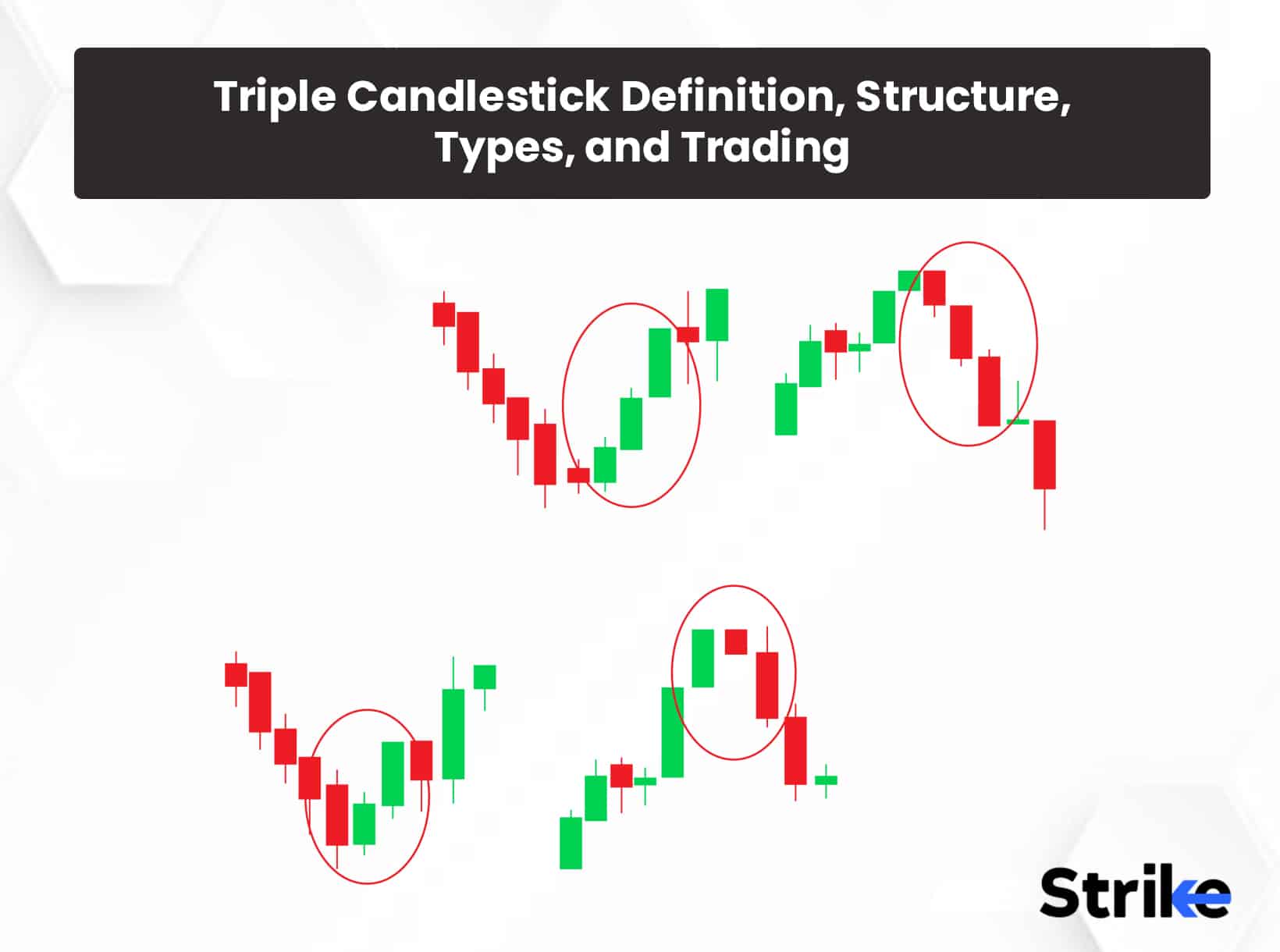





 Previous Article
Previous Article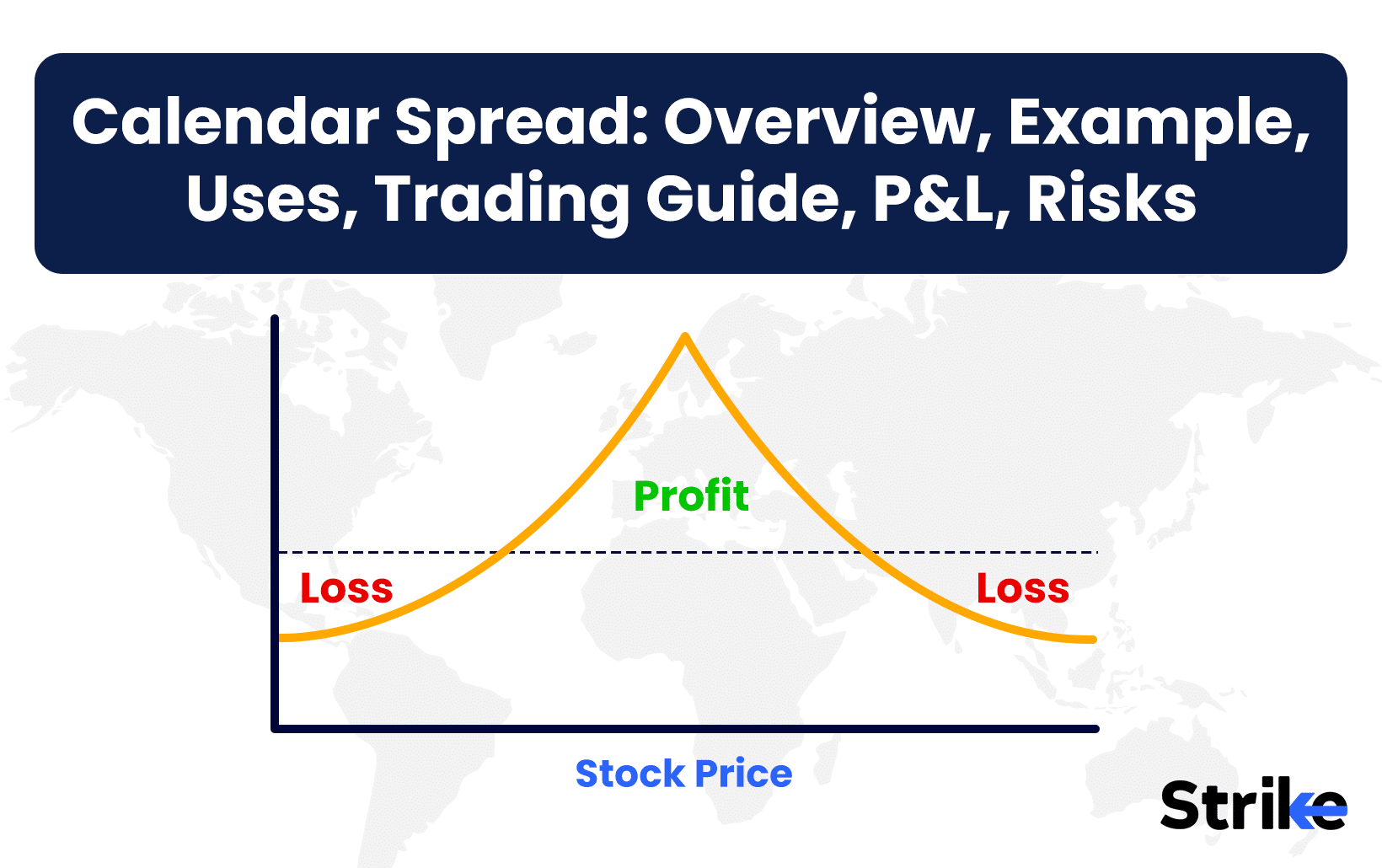
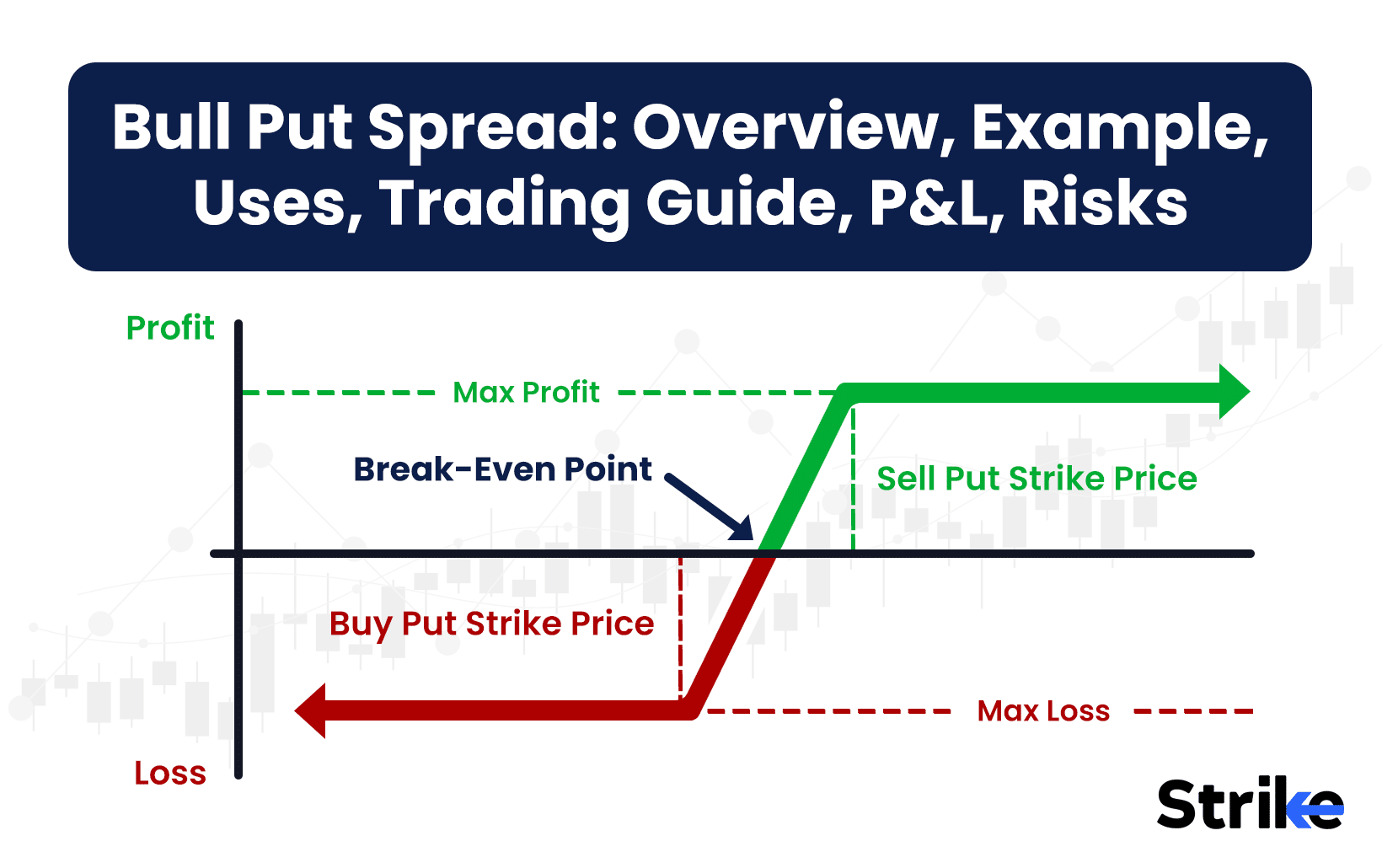





No Comments Yet